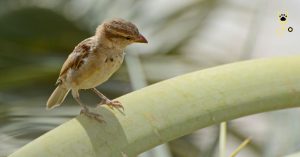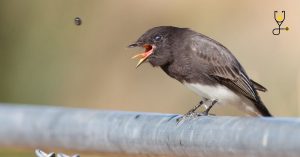Ever watched a bird from your window, flitting about in its own little world, blissfully unaware of the human eyes watching its every move? But when it stops and hangs upside down for seemingly no reason at all – does that make you curious to know why birds hang upside down, could there be more mysteries behind this unique behavior than meets the eye? As it turns out, hanging upside-down is quite normal for birds and here we’ll go deeper into discovering 15 different reasons why do birds hang upside-down! From cleaning & stretching after sleep to mood swings & playing around with friends; each one of these reasons has an important role in their day-to-day bird life. Read on further to explore them yourself!
Similar topic: 6 Reasons “Why Is Your Pet Bird Screaming?”

Why Do Birds Hang Upside Down?
1. Grooming
Just like us, humans, birds also take time to groom themselves every now and then! Hanging upside-down makes it easier for them to reach any unkempt feathers on their back by using their beaks – making sure they look their best all the time.
2. Stress Relief
Birds are quite active animals and often find themselves in stressful situations due to predators or other such threats around them. Hanging upside down gives them a chance to relax, unwind and get away from any possible danger lurking around.
3. Stretching
After sleeping for long periods of time, birds tend to hang upside-down as a way to stretch out their bodies – particularly their wings. This process helps them get ready for the day and gives them a full range of motion to fly around freely.
4. Cooling Off
Birds never sweat, so in order to cool down their body temperatures during the hot summer months they turn upside-down and hang as a way to release heat from their bodies.
5. Mood Swings
Studies suggest that birds have mood swings just like us humans! And when a bird is feeling stressed, angry or depressed it sometimes hangs upside-down as a way to cope with the situation – just like taking deep breaths does for our species.
6. Socializing
Hanging upside-down is also used by some birds as a form of communication with other members of their flock. This behavior is mostly observed between juvenile birds, who use it as a way to bond and play around together.
7. Eating
Some types of birds prefer to eat while hanging upside-down – a great example would be the hummingbird, which can often be seen hovering above flowers and then flipping itself over to reach the nectar inside.
8. Heating Up
On chilly winter days, some birds will hang upside down in order to warm up their bodies by trapping heat close to them, thus keeping them cozy and comfortable throughout the colder seasons of the year.
9. Displaying Dominance
In some cases, certain species of birds will engage in an upside-down display in order to convince other birds that they’re the alpha in their flock – this is usually seen in larger species such as hawks and eagles.

10. Prey Detection
Hanging upside-down gives birds a better range of vision, enabling them to detect potential prey from a greater distance and height – making for an easier catch!
11. Predator Alerts
Similarly, some birds may hang upside down in order to spot any possible predators or danger around them before taking off into the sky.
12. Resting
Last but not least, hanging upside-down also acts as a way for birds to take a break after long periods of flying or eating – giving them time to rest up and get ready for the next activity.
13. Attracting a Mate
In the mating season, it is common to see male birds hanging upside down as part of their courtship display. This behavior shows off their strength and agility, which can be quite attractive for potential mates!
14. Sunning
Birds also like to hang upside-down in order to sun themselves – allowing them to absorb any heat and light being emitted from the sun’s rays. This helps keep their feathers warm and dry for future flights.
15. Shedding Feathers
Finally, some birds may choose to hang upside-down as part of a natural process called molting or replacing old feathers with new ones. By using gravity they make it easier for them to shed their old feathers – leaving them with a fresh, new look.
Overall, hanging upside-down serves many different purposes for birds and is an important part of their everyday lives. Although it may seem strange to us human onlookers, it’s actually quite natural and necessary for our feathered friends!

Conclusion
It’s clear that there are many complex reasons why birds hang upside-down – from stress relief to displaying dominance and even detecting prey in the area. This behavior has been observed for centuries, and it is a testament to the incredible adaptability of these amazing creatures! Thanks for reading, we hope you’ve learned something new about our feathered friends. Until next time!
You may also be interested in: 8 Tips to Teach Your Pet Bird to Talk
Frequently Asked Questions
The most common reason for birds to hang upside down is for grooming purposes. It makes it easier for them to reach any unkempt feathers on their backs and make sure they look their best at all times.
Absolutely! Hanging upside-down can be used as a way of stress relief, stretching out your body, cooling off, and even spotting predators or prey in the area. By observing this behavior we can gain insight into how animals cope with different situations – something that we humans can certainly use in our own lives.
Hummingbirds are probably the species that hang upside down the most, as they do so in order to reach nectar from flowers. Other birds such as hawks, eagles, and juvenile birds may also display this behavior for various reasons.
Generally speaking, no. This behavior is perfectly natural and safe for birds – they have evolved to be able to do this comfortably and securely. However, as with any type of activity, excessive or prolonged hanging can lead to fatigue or other issues so it’s important to keep an eye on your feathered friends at all times!
The best way to encourage your pet bird to hang upside-down is by providing them with a safe, secure perch – such as a rope or ladder – from which they can comfortably and securely suspend themselves. You could also offer treats or toys that your bird can interact with while hanging in order to make it more enjoyable for them. Lastly, be sure to provide plenty of space for your pet so they have enough room to safely maneuver around!
Comment below if you have any more questions about birds hanging upside-down and we’ll be happy to answer them! Thanks for reading, and happy bird-watching! ????








